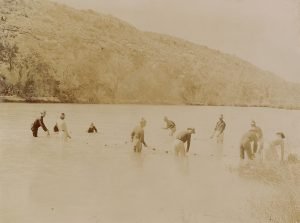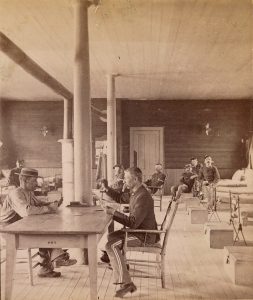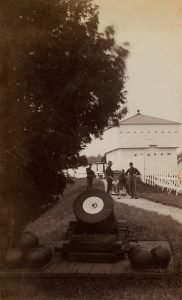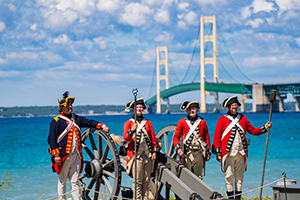
If you’ve visited Fort Mackinac, you’ve probably seen our historical interpreters performing demonstrations and leading tours while wearing the uniforms of the U.S. Army of the 1880s. We strive to have accurate reproductions, but what did the historic soldiers of Fort Mackinac wear under their uniforms?

The British and early American soldiers on Mackinac Island probably wore a single piece of underwear in the form of a long-sleeved linen shirt. The shirts usually reached almost to the knees, allowing the soldiers to wrap them around their upper legs and groin. Shirts were changed and laundered regularly, as having clean linen against the skin was considered essential to staying healthy. By the 1880s, the American army provided considerably more complex undergarments, which could be mixed and matched in layers depending on the climate and a soldier’s needs. By the mid-1870s, soldiers were regularly issued drawers to wear beneath their uniform trousers. Made of unbleached flannel, the drawers issued by the mid-1880s had a reinforced crotch and a full-cut seat, and closed with two metal buttons in front as well as buttons to close the ankle cuffs. Beginning in 1881, soldiers also received an undershirt to wear against their skin. Made of a 50/50 blend of fleece wool and cotton, the gray pullover shirts had knit cuffs to ensure a snug fit around the wrists. Soldiers received three undershirts as part of their yearly uniform allowance, but they often complained that the shirts were too hot and heavy, especially for men stationed in the south or the deserts of the southwest. Soldiers also began receiving blue flannel shirts, worn over the undershirt, in 1881. After receiving feedback (meaning complaints) from soldiers about the 1881 shirts, the Quartermaster Department issued a new design in 1882, and again in 1883. The 1883 model shirts were cut in much the same way as the undress blouse, with a falling collar and fitted cuffs. These shirts featured three black rubber buttons at the throat and down the front placket, which extended to mid-chest. The shirts also included two breast pockets, each with a single black rubber button for closure. The army always intended for these shirts to be worn as outerwear in hot climates, and soldiers were issued three every year.

man standing at center, sideways to the camera, may also be wearing his gray undershirt- note his forearm.
By layering these garments as needed, soldiers could somewhat adapt to changing weather and keep a ready supply of clean undergarments on hand. Although it’s not something that visitors to Fort Mackinac ever see (and would have only rarely seen back in the 1880s), these pieces of underwear were critical to creating the look of the U.S. Army in the late 19th century. Be sure to ask the interpreters about their uniforms next time you visit Fort Mackinac, and don’t forget to check out Mackinac Associates, which helps fund the purchase of uniforms and other supplies every year. Also, if you’re interested in seeing more images of army life in the 1880s, this summer Mackinac State Historic Parks is pleased to offer a new book featuring over 120 images collected by a Fort Mackinac officer: Through an Officer’s Eyes: The Photo Album of Edward B. Pratt, U.S. Army 1873-1902. The three images illustrating this post all come from the book, which will be available in our visitor’s centers and museum stores.









